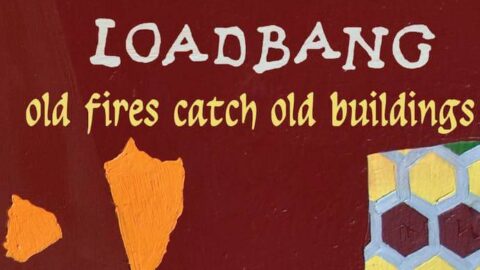I’m not the first to note the aeolian bias of loadbang’s unique lineup. Three years on from their previous release in Lungpowered, commentators on old fires catch old buildings, released in May 2018 by New Focus Recordings, still mention the ensemble’s peculiar constellation of tone colors—comprising baritone Jeffrey Gavett, clarinetist Carlos Cordeiro, trumpeter Andy Kozar, and trombonist William Lang—in almost automatic fashion.
It’s easy to brand the group as another curio pulling itself up by its bootstraps in a contemporary music scene crowded with eccentric instrumentations the likes of which Berlioz and Rimsky-Korsakov could scarcely have imagined. At a closer look, though, their very existence reads like a history lesson in disguise: as major orchestras and chamber music organizations devote more time, money, and program space to the 19th through early 20th-century repertoire and its later imitations, new music diehards assemble in ever-more unorthodox, portable combinations. That’s nothing new, and it’s to the credit of the composers on old fires catch old buildings that the music isn’t limited to Orchestration 101 timbre studies.
“Lung power” remains relevant here nonetheless, in that almost every featured work has in some way to do with voice—both literal (as in the frequent focus on Gavett’s piquant high register—an unforgettable, instantly recognizable sound) and metaphorical. In a range of works full of speech and whispers, matters of expression—especially strained, frustrated, or impossible expression—are conflated with those of projection.

Questions of deconstructed verbal and musical language are already foregrounded in Taylor Brook’s Ouaricon Songs: Volume 2, in which a precarious, microtonal sinew of almost-folk-melody winds through imaginary territories of a speculative North American continent. There is a palpable sense of giddy and fearful possibility, of groping in the dark, which is momentarily cheapened on several occasions by recourse to too-literal evocations of old popular tunes—but the work’s underlying expressive impulse, both celebration and memento mori for the flotsam of North American culture, remains undiluted.
Two barely-whispered pieces by Reiko Füting and William Lang follow, offset by more extroverted offerings of Gavett and Angélica Negrón. Füting’s mo(nu)ment for C, written as a memorial for victims of the 2015 Charlie Hebdo shooting, opens with hushed, shuddering pulsations of breath and fricatives, at first intermittently colored by single pitches and gradually developing into a tangle of pitched oscillations. Text (“Je suis”–“I am”–“Ich bin”) is never more than faintly discernible, and the “mechanical” influence of Ligeti never seems far off: the theatrical clockwork of wiped-over syllables evokes a fretful, sometimes rancorous Ligetian spirit as much as the pensive solidarity implicit in the work’s text.

Hushed repetitions and stylistic reminiscences also feature prominently in Lang’s Sciarrino Songs, whose four brief episodes, ranging in length from 24 seconds to a minute and a half, are replete with the delicate pianissimo shadings and hieratic utterances characteristic of their namesake. Lang’s division of the Songs into separate movements seems gratuitous at first, but the demarcated stillness of his approach gradually gives a ceremonial feeling, as though each movement were a glimpse into some longer, inscrutable litany of severely-circumscribed chants.
In terms of instrumental approach, the contributions of Angélica Negrón and Jeffrey Gavett—doabín and Musicorum et Cantorum, respectively—seem like natural program companions to those of Füting and Brook. Like Füting, Negrón constructs a vertiginous hocket of breath and language, in this case overlaid on cryptic recordings of children’s speech. The work is inspired by a true case of “twin talk” documented in the 1970s, and though its sunny groove provides expressive contrast in a program of comparatively serious music, its simple, pop-inflected excavation of a backstory filled with exploitative and isolating details leaves a nagging sense of disconnect. Gavett fares better—in Musicorum et Cantorum he succinctly explores the relationship between singing and playing in vivid, rough-edged timbral composites that sometimes recall the heterophonic undulations of Ouaricon Songs.
Paula Matthusen and Scott Wollschleger provide the album’s closing works. Matthusen’s old fires catch old buildings begins unassumingly, with sustained chords and bluesy melodic fragments drifting in a soundscape of live and prerecorded performances. Approximately midway through, there is a disarming moment of focus as Gavett sings in falsetto over distorted doubling, the parts’ strict unison fraying slightly over approximately a minute’s duration. In context the effect is striking, Narcissus-like, and this spare centerpiece proves to be the work’s most compelling passage.

Wollschleger’s What is the Word takes as its basis the final text of Samuel Beckett, and though the Irish playwright’s oeuvre is more complex than a simple text-setting can hope to accommodate, Wollschleger’s approach is not quite this: part recitation, part instrumental abstraction, the composer harnesses a deliberately-limited catalogue of sonic materials to convey an altogether personal response to the Beckett source in a triptych of quietly obsessed miniatures.
Though they arrived on the scene without a repertoire to speak of, loadbang’s decade-long output now speaks for itself in quality and depth of involvement. The program collected here is fastidiously performed and curated, and the recorded sound engineered by Ryan Streber is close but not overly precious. The featured composers—far from treating the quartet as a novelty—each demonstrate careful attention both to the group’s diverse timbral and technical resources and to the exigencies of their own creative vision. With a substantial roster of collaborations and three full-length albums now behind them, loadbang has reached a happy milestone in old fires catch old buildings—may we hear them in many more.
























